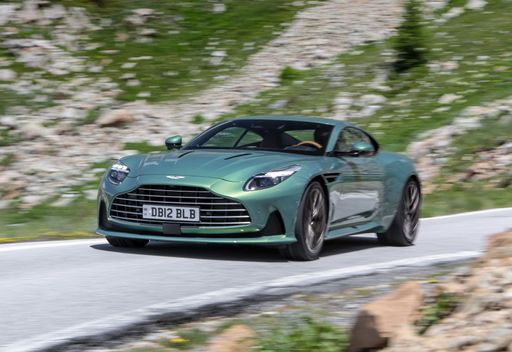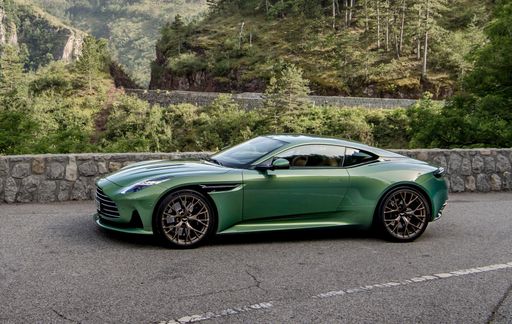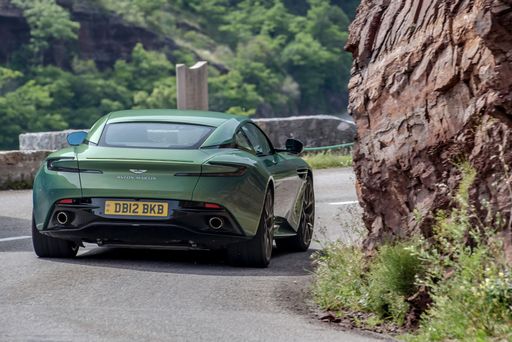When it comes to British luxury sports cars, Aston Martin reigns supreme, blending elegance with performance. In this article, we will compare the Aston Martin DB12 and the Aston Martin Vantage, exploring their technical aspects, performance metrics, and innovative features. Each car possesses its unique flair, making the choice between them a delightful yet challenging journey.
Aston Martin DB12 vs Aston Martin Vantage – Performance, range & efficiency compared
Everyday use, family trips or long-distance drives – here’s where the differences show.
Discover whether Aston Martin DB12 or Aston Martin Vantage fits your lifestyle better.
Power and Performance: A Closer Look
The heart of both the DB12 and the Vantage is a robust 4.0-liter V8 engine. However, in terms of output, the DB12 takes the lead with an impressive 680 HP compared to the Vantage's 665 HP. This difference translates into marginally better performance for the DB12, with a 0-100 km/h acceleration time of 3.6 seconds, slightly lagging behind the Vantage's swift 3.5 seconds.
Handling and Drive
Both models feature rear-wheel drive and automatic gearboxes, ensuring an exhilarating driving experience. The DB12, with a curb weight of 1,788 kg, feels dynamic yet luxurious, providing a smooth ride. In contrast, the Vantage's lighter frame at 1,745 kg enhances its agility, making it a more responsive production.
Dimensions and Design
In terms of dimensions, the DB12 is longer at 4,750 mm and wider at 1,950 mm, offering a more spacious cabin that accommodates four seats. The Vantage, being more compact at 4,495 mm in length and 1,980 mm in width, is designed primarily for two, emphasizing a sporty, driver-focused experience. Both vehicles proudly display Aston Martin's iconic design language, with sleek lines and striking profiles that turn heads wherever they go.
Fuel Efficiency and Environmental Impact
Both cars exhibit impressive fuel efficiency for high-performance machines. The DB12 records a consumption of 12.2 L/100km, while the Vantage marginally edges it out with 12.1 L/100km. Their CO2 emissions ratings are quite similar, with the DB12 at 278 g/km and the Vantage at 274 g/km, falling into the same CO2 efficiency class “G.”
Innovative Features
The Aston Martin DB12 represents the latest in automotive innovation, equipped with cutting-edge technology and luxury appointments. Inside the DB12, drivers are greeted with advanced infotainment systems, premium materials, and customizability that underscores its status as a grand tourer. The Vantage, while slightly less opulent, still boasts a modern interior, complete with the latest technological advancements and a focus on driver engagement.
Trunk Space: Practicality Meets Performance
One of the practical differences lies in their trunk capacity. The DB12 offers no trunk space, prioritizing back seat space for passengers, while the Vantage includes a functional 235 liters, catering to the needs of sports car enthusiasts who appreciate storage options without compromising performance.
Conclusion: The Perfect Choice for You
Choosing between the Aston Martin DB12 and the Vantage boils down to individual preferences. The DB12 shines in power, luxury, and passenger space, making it a suitable choice for those seeking a grand tourer experience. Meanwhile, the Vantage, with its nimble handling and sportier focus, appeals to driving purists who revel in the art of performance. Whichever model you choose, rest assured that you are embracing the timeless appeal and exhilarating performance that only Aston Martin can deliver.
Here’s where it gets real: The technical differences in detail
Costs and Efficiency:
Price and efficiency are often the first things buyers look at. Here it becomes clear which model has the long-term edge – whether at the pump, the plug, or in purchase price.
Aston Martin Vantage has a slightly advantage in terms of price – it starts at 169700 £, while the Aston Martin DB12 costs 192900 £. That’s a price difference of around 23143 £.
Fuel consumption also shows a difference: Aston Martin Vantage manages with 12.10 L and is therefore hardly perceptible more efficient than the Aston Martin DB12 with 12.20 L. The difference is about 0.10 L per 100 km.
Engine and Performance:
Power, torque and acceleration are the classic benchmarks for car enthusiasts – and here, some clear differences start to show.
When it comes to engine power, the Aston Martin DB12 has a barely noticeable edge – offering 680 HP compared to 665 HP. That’s roughly 15 HP more horsepower.
In acceleration from 0 to 100 km/h, the Aston Martin Vantage is barely noticeable quicker – completing the sprint in 3.50 s, while the Aston Martin DB12 takes 3.60 s. That’s about 0.10 s faster.
There’s no difference in top speed – both reach 325 km/h.
Both models offer the same torque – 800 Nm.
Space and Everyday Use:
Cabin size, boot volume and payload all play a role in everyday practicality. Here, comfort and flexibility make the difference.
Seats: Aston Martin DB12 offers significantly more seating capacity – 4 vs 2.
In curb weight, Aston Martin Vantage is hardly perceptible lighter – 1745 kg compared to 1788 kg. The difference is around 43 kg.
In terms of boot space, the Aston Martin DB12 offers to a small extent more room – 262 L compared to 235 L. That’s a difference of about 27 L.
Who wins the race?
The Aston Martin DB12 proves to be secures victory with a clear margin and therefore becomes our DriveDuel Champion!
Aston Martin DB12 is the better all-rounder in this comparison.
 @ Aston Martin Lagonda
@ Aston Martin Lagonda
Aston Martin DB12
Aston Martin DB12
The Aston Martin DB12 exudes a perfect blend of sophistication and performance, establishing itself as a cornerstone of automotive excellence. Its sleek design is matched by a meticulously crafted interior that prioritises both comfort and luxury. With an impressive combination of cutting-edge technology and driving dynamics, this vehicle offers an unparalleled experience for enthusiasts and connoisseurs alike.
details @ Aston Martin Lagonda
@ Aston Martin Lagonda
 @ Aston Martin Lagonda
@ Aston Martin Lagonda
 @ Aston Martin Lagonda
@ Aston Martin Lagonda
Aston Martin Vantage
The Aston Martin Vantage captivates with its striking design and luxurious interior, embodying the spirit of a classic British sports car. Its powerful performance and agile handling make it a thrilling choice for driving enthusiasts seeking an engaging ride. Crafted with meticulous attention to detail, the Vantage seamlessly blends elegance and dynamism, setting a benchmark in its class.
details
 @ Aston Martin Lagonda
@ Aston Martin Lagonda
|
|
|
|
|
Costs and Consumption |
|
|---|---|
|
Price
192900 - 207900 £
|
Price
169700 - 188600 £
|
|
Consumption L/100km
12.20 L
|
Consumption L/100km
12.1 - 12.3 L
|
|
Consumption kWh/100km
-
|
Consumption kWh/100km
-
|
|
Electric Range
-
|
Electric Range
-
|
|
Battery Capacity
-
|
Battery Capacity
-
|
|
co2
276 - 278 g/km
|
co2
274 - 279 g/km
|
|
Fuel tank capacity
78 L
|
Fuel tank capacity
73 L
|
Dimensions and Body |
|
|---|---|
|
Body Type
Coupe, Convertible
|
Body Type
Coupe, Roadster
|
|
Seats
4
|
Seats
2
|
|
Doors
2 - 3
|
Doors
2 - 3
|
|
Curb weight
1788 - 1898 kg
|
Curb weight
1745 - 1805 kg
|
|
Trunk capacity
206 - 262 L
|
Trunk capacity
0 - 235 L
|
|
Length
4725 mm
|
Length
4495 mm
|
|
Width
1980 mm
|
Width
1980 mm
|
|
Height
1295 mm
|
Height
1275 mm
|
|
Max trunk capacity
-
|
Max trunk capacity
-
|
|
Payload
-
|
Payload
-
|
Engine and Performance |
|
|---|---|
|
Engine Type
Petrol
|
Engine Type
Petrol
|
|
Transmission
Automatic
|
Transmission
Automatic
|
|
Transmission Detail
Automatic Gearbox
|
Transmission Detail
Automatic Gearbox
|
|
Drive Type
Rear-Wheel Drive
|
Drive Type
Rear-Wheel Drive
|
|
Power HP
680 HP
|
Power HP
665 HP
|
|
Acceleration 0-100km/h
3.6 - 3.7 s
|
Acceleration 0-100km/h
3.5 - 3.6 s
|
|
Max Speed
325 km/h
|
Max Speed
325 km/h
|
|
Torque
800 Nm
|
Torque
800 Nm
|
|
Number of Cylinders
8
|
Number of Cylinders
8
|
|
Power kW
500 kW
|
Power kW
489 kW
|
|
Engine capacity
3982 cm3
|
Engine capacity
3982 cm3
|
General |
|
|---|---|
|
Model Year
2023 - 2024
|
Model Year
2024 - 2025
|
|
CO2 Efficiency Class
G
|
CO2 Efficiency Class
G
|
|
Brand
Aston Martin
|
Brand
Aston Martin
|
Is the Aston Martin DB12 offered with different drivetrains?
Available configurations include Rear-Wheel Drive.
The prices and data displayed are estimates based on German list prices and may vary by country. This information is not legally binding.
